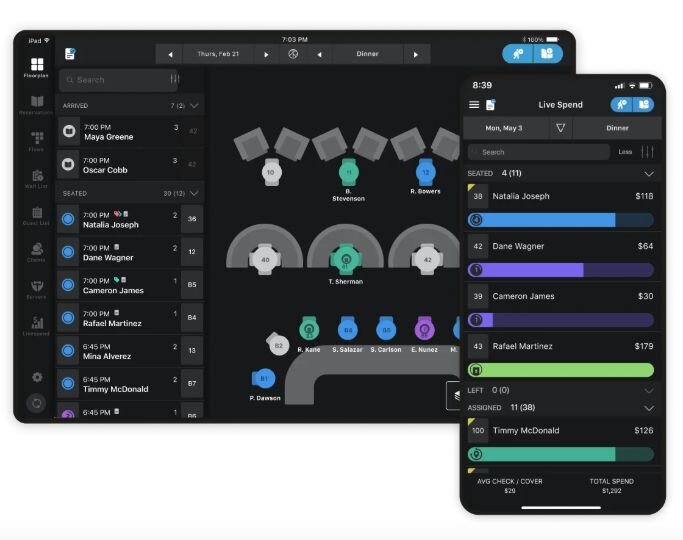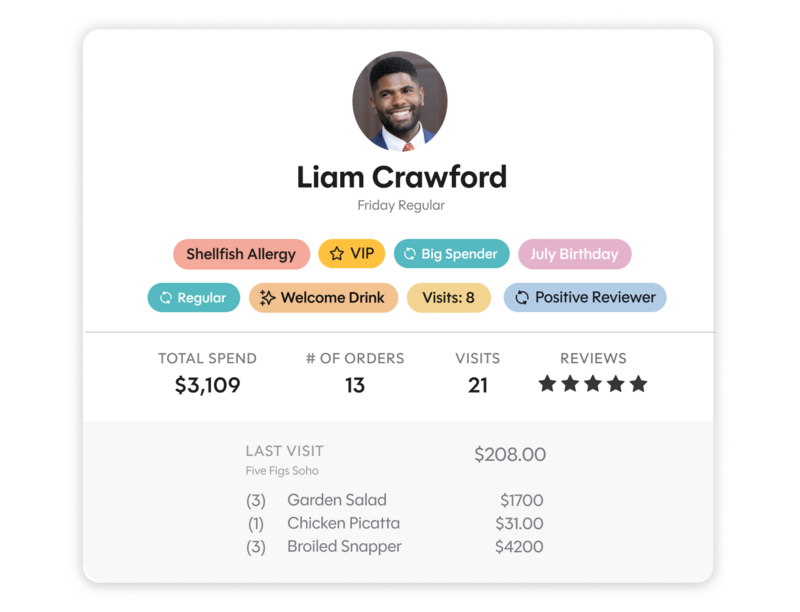How to Master Your Restaurant Pre-Shift [Free Checklist]

Katelyn Andrews
5 min read
Jul 3, 2025
![How to Master Your Restaurant Pre-Shift [Free Checklist]](/_next/image/?url=https%3A%2F%2Fcdn.builder.io%2Fapi%2Fv1%2Fimage%2Fassets%252Facabda4a1104467f93cbad15a924c9a3%252F952b236bcad544298ce07979986e611f&w=1920&q=75)

Katelyn Andrews
5 min read
Jul 3, 2025
![How to Master Your Restaurant Pre-Shift [Free Checklist]](/_next/image/?url=https%3A%2F%2Fcdn.builder.io%2Fapi%2Fv1%2Fimage%2Fassets%252Facabda4a1104467f93cbad15a924c9a3%252F952b236bcad544298ce07979986e611f&w=1920&q=75)
Expecting the unexpected is a prerequisite for running a restaurant: a server calls out last minute, a popular dish is 86’d, a VIP endures bad service or the ice machine breaks. There are 100 things that could go wrong, but restaurants that plan ahead are better equipped to overcome that panic-inducing, what-do-we-do-now kind of chaos we’ve all experienced once (or twice) before.
Pre-shift, or pre-service briefing, is one of the most important yet understated components of running a successful restaurant. Consistent pre-shifts can help improve operational efficiencies, mitigate potential risks and boost restaurant sales.
Find out exactly what it takes to run a successful pre-shift and use our free, downloadable template to ensure you never miss a detail.
A coach wouldn’t send their players into the field without a pregame huddle — just like a restaurant manager wouldn’t release their staff onto the floor without the details to impress guests and maximize every seat. Every shift is like gameday for your staff. It’s your job to ensure everyone is prepped, aligned and equipped to perform. If you’re on the fence about adding a daily pre-shift to your schedule, check out some of the benefits below.
Don’t limit your pre-shift meetings to your FOH team; invite your BOH staff as well to ensure everyone is in sync. Aligning the front and back of the house builds greater restaurant awareness that everyone benefits from, including the customer.
Below are the most common and important elements to help you prepare for a successful shift.
Sharing helpful information about your restaurant business, external industry news, policy updates and other important updates help convey how these circumstances may impact shift ahead as well as the business overall.
Reviewing your floor plan before an upcoming shift ensures everyone knows exactly where they’re supposed to be and what they’re responsible for. This is especially important if you’re switching up your floor plan to accommodate larger parties or holidays, such as group events, Valentine’s Day or Mother’s Day, that might require new seating arrangements.
You can print out an updated version of your floor plan for your staff to review from your reservation system or create one manually.

Preparations for a holiday or event don’t have to fall squarely on your shoulders. SevenRooms’ AI-driven seating algorithm considers 10,000+ combinations every second based on your reservations and waitlist. Share these floor plans and pre-shift reports so your team is equipped to handle the rush.
Are you totally booked or do you have room to accommodate walk-ins and last-minute reservations? It’s essential to review your reservations before a shift to accurately gauge the total guest count and ensure adequate coverage. Both the FOH and BOH should be aware of the rush and your hosts ready to manage potential waitlists if there’s any increase in foot traffic.
This is particularly important for the kitchen staff to know so they can prepare beforehand.
To get more tips on how to more efficiently manage your cover flow and streamline operations, check out our Revenue Management Guide.
Delivering an exceptional guest experience requires attention to detail. Review your reservation system to call out reservation notes, special guests, allergies and accommodations. Below are some typical guest details to include.
With SevenRooms’ table management software, you don’t need to visit multiple sources to retrieve this information for pre-shift. The platform allows you to filter reservations to quickly identify VIP experiences, special parties and celebrations, which you can use to plan table touches during your pre-shift huddle.
Here is the saMake it easier for your staff to collect and store valuable guest data information by building individual guest profiles. SevenRooms’ hospitality CRM automatically tracks over 100 unique data points for every diner to help your team level-up service.

Pre-shift is an excellent opportunity to announce menu changes and educate your staff.
Invite your chef to give an overview and offer a tasting of new menu items. This is a great opportunity for staff to learn how the dish is made or to gather special details they can share with guests. Similarly, your sommelier or beverage director can give a quick wine-tasting or cocktail demo to introduce a new addition to your beverage menu.
This allows staff to ask questions about new dishes and get recommendations on how to explain or pronounce certain ingredients. If you’ve had to increase your menu prices, your staff will be better equipped to explain the reasons for the change. The more knowledgeable your staff is, the better the guest experience and contribution to the bottom line.
Whether it’s selling gift cards, upselling appetizers and desserts or promoting a wine and dish pairing. Educate and motivate your team to drive sales with add-ons and upsells. After all, if your staff relies on tips, a higher check average benefits them just as equally.
Your pre-shift is a perfect opportunity to identify ways your staff can make personalized recommendations based on the shift’s menu, such as drinks, appetizers, desserts and side dishes based on guest data stored in your CRM. When you know your guests and their order history, you can recommend items that increase spend.
Running a contest can be a fun way to gamify and incentivize upselling opportunities. Reward your staff with incentives they’ll love like a free bottle of wine, free meals or no side work for a week.
Finally, end your huddle by acknowledging or recognizing team members who did an outstanding job. Thank your line cooks who handled rushes with ease, a server for exceeding sales goals or a staff member who received a shoutout in a guest review.
Genuine, sincere praise is a great motivator for keeping staff engaged and productive.
A good pre-shift requires preparation. Not only does it help you organize but it shows your staff professionalism and respect. Their time before a shift is just as valuable as yours; don’t waste it by being unprepared.
A good pre-shift requires preparation. Not only does it help you organize but it shows your staff professionalism and respect. Their time before a shift is just as valuable as yours; don’t waste it by being unprepared.
Most restaurants have a standardized pre-shift template for managers to print and fill out. Oftentimes, this requires pulling information from multiple sources to organize talking points.
Leveraging technology can make pre-shift prep more efficient. An integrated reservation solution like SevenRooms gives managers some time back. By connecting your reservation software, POS system and reviews, SevenRooms Table Management automatically collects, stores and presents all of the insights you need to conduct your preshift in one place.

SevenRooms’ client, Nicholas Ingall, Operations Manager for the Apollo Group in Australia, transitioned from a printed pre-shift to SevenRooms’ solution.
“Pre-Shift is a great resource for our service leaders, waiters, bartenders and chefs. It is having a notable effect in training our kitchen teams and their restaurant awareness. The kitchen is reviewing cover flows, service notes and goals for the front of house team in one view. Pre-Shift enables our front and back of house teams to maintain a big picture view of the restaurant while managing in detail,” Nicholas shared. Find out more by reading the full Pre-Shift case study.
Haphazard pre-shifts will do more harm than good. Commit to a regular format and keep it brief — five to 30 minutes is all you need to align and engage.
For example, here’s an idea for an efficient 20-minute preshift meeting format:
Choose an area away from distractions such as the back of the restaurant or an unoccupied private room. Keep that space, and the timing, consistent so the staff knows where to gather for every briefing.
Come to each huddle prepared to end on a high note. Remember that sharing the good with the bad keeps staff engaged and energized (i.e., plating looks great, but table turnover could be quicker). Reward good work and shoutout employees who are raising the bar of service.
Finally, encourage your team to ask questions, provide feedback and share ideas. Involving your staff can make them feel more connected to the team and the business.
Whether you use a printable pre-shift template or a digital one, building a consistent, repeatable routine is key to running a smooth service.
SevenRooms makes it easy to run efficient, effective pre-shift meetings. With Table Management, you can generate real-time, customizable reports that help your team plan ahead and operate at their best.
Every shift is different. That’s why your team needs to stay agile—ready to respond to changing demand and guest needs. With SevenRooms, you can empower your staff before service starts and streamline front-of-house operations to get the most out of every seat, let our team show you with a personalized demo.
Pre-shift meetings should be held before every shift with the goal of informing, educating and motivating your staff so they are prepared to serve your guests.
Pre-shift meetings can range anywhere from five to 30 minutes before a shift. How much time you need depends upon the goals of your pre-shift and size of your team.
Post-shift is the opposite of pre-shift, conducted at the end of a shift. Post-shift meetings include responsibilities such as cleaning up workstations, turning off or disassembling equipment, writing up shift summaries and closing out opened checks to help prepare for the next shift.
Download this checklist to run your most efficient pre-shift.